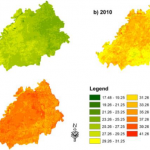
Urbanization and its Impact on Land Surface Temperature
March 5, 2024
Big Questions in Climate Change
March 6, 2024
Urbanization and its Impact on Land Surface Temperature
March 5, 2024
Big Questions in Climate Change
March 6, 2024
Speed Management Policy
Problem
Road Safety is a pressing issue in urban environments. According to the WHO, Approximately 1.3 million people die each year due to road traffic crashes[1]. Even more alarming is that 93% of RTCs happen in low to middle-income countries[2], which is extremely disproportionate to the number of vehicles in these countries. Moreover, Road traffic crashes cost most countries 3% of their gross domestic product[3]. In Pakistan, 40,000 crashes took place in 2016[4]. Data reveals that in most road crashes, motorcyclists and pedestrians are the most vulnerable. In 83 per cent of recorded crash victims are associated with motorbikes[5].
Research
As the number of cars grows and cities expand, road traffic accidents are bound to happen. Humans are prone to mistakes but our job is to design a road network and implement policies that mitigate the harm related to those mistakes. Our roads, emergency services, and road safety policies need to eliminate the risk of death in RTCs.
One of the most crucial factors in reducing fatalities is speed. The WHO estimates that an adult pedestrian has less than a 20% risk of dying if struck by a car travelling below 50 km/h, but almost a 60% risk of dying if hit at 80 km/h[1]. An increase of 1 km/h in mean vehicle speed results in a rise of 4¬5% in fatal crashes[2]. Similarly, a 5% cut in average speed can reduce the number of deadly road.
Recommendations
The recommendations for speed management are divided into two areas. The first one caters to establishing and implementing safe speed. The second section delves into speed-calming measures that can be used to slow down drivers.
Establishing Proper Speed Limits
International standards decree that a speed of 35km/h is the safest in urban neighbourhoods. At this speed, the reaction and braking time are maximized. Even in cases of collision with a pedestrian and motorcyclist, the chances of death are minimal. The speed limits need to be clearly posted and the penalties should also be clearly mentioned. Penalties increase in severity if the offence is repeated. Penalties shouldn’t be so severe that no one is able to pay them. Moreover, having a separate traffic court that deals with traffic offences streamlines the process.
Enforcing Speed Limits
Cameras are far more effective in catching people who break the speed limit. They are also less susceptible to bias or corruption. Installing a good network of cameras is essential in implementing speed limits
Raising Awareness
Campaigns that focus on the surety of getting caught and the swiftness of punishment ensure compliance with road safety rules the most. letting people know that they’re being watched (by a camera or a person) is effective. Also, advertisements that display how many people got caught breaking the law are also effective in ensuring compliance.
Speed Calming Measures
1. Corner Radii
A safe turning speed is determined to be 15 km/h or less. Having a bigger corner radius can reduce speed but also give the driver more time to react to people and cars that are coming from the other side. The standard corner radius is 10 to 15 feet.

2. Pinch Points
A pinch point is created by decreasing the width of the road by using curbs, parking, or trees. Pinch points force motorists to slow down by narrowing the road. A pinch point can also extend the sidewalk and create a raised pedestrian crossing as well.

3. Chicanes
Chicanes can be used to slow down drivers by forcing them to follow an S-shaped pattern. Using temporary curb extensions, trees, planters, paint or parking spaces to create the chicane effect is also cheaper than concrete curb extensions. Additionally, this also creates more public space in the area.

4. Speed Table
Speed Tables raise the entire wheelbase of a vehicle to reduce its traffic speed. They are longer than Speed Humps and flat-topped. They can also be used at crosswalks to create a raised pedestrian crossing as well.

5. Speed Cushion
Speed Cushions can reduce the speed of smaller vehicles while allowing larger vehicles to pass over them. This is particularly helpful for Arterial roads that serve buses or trucks as well.

Implementation Roadblocks
The WHO strongly recommends the Safe Systems approach to road safety. The approach is a holistic policy that focuses on building safe roads, implementing safe speeds, manufacturing safe vehicles, ensuring safe road users and providing post-crash care to victims. All of these aspects of policy need to be woven together to create a city with city that has 0 fatal or serious road accidents. However, the implementation of such a policy needs government coordination across departments. Pakistan has created a new Road Safety Authority this year that will oversee the implementation of the Safe Systems approach. Currently, though, our road safety policy is scattered at best. Individual departments handle different aspects of road safety with little to no data sharing and collaboration. That needs to change. The reason we began with speed management is because it is the easiest place to start. However, it is to be remembered that it is only the beginning of a robust policy. The state of our roads, the cars we allow on them, the behaviour of our drivers and the efficiency of our post-crash care providers need to be evaluated before we can even begin to fix them. To this end, robust data collection is a crucial starting point. In the age of data science and artificial intelligence though, it is high time the government utilizes the tools available to make our cities safe to live, walk and drive in.
Reference
- 1 Road traffic injuries. (2022). Retrieved from https://www.who.int/news-room/fact-sheets/detail/road-traffic-injuries
- 2 Ibid.
- 3 Ibid.
- 4 Shafqat, M. (2017). Retrieved from https://tribune.com.pk/story/1570182/pedestrian-road-safety-talking-talk-not-walking-walk
- 5 Basheer, D. M. A. (2023). Retrieved from https://thefridaytimes.com/31-Aug-2023/motorbike-crashes-can-roads-be-made-safer
- 6 WHO. (2017). (publication). Managing Speed.
- 7 Ibid.
- 8 Therefore, the first step of an effective road safety policy is to impose safe speed limits on vehicles.

